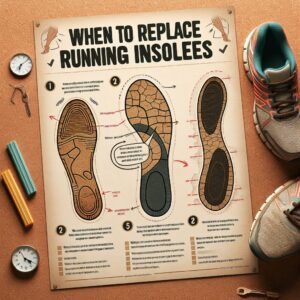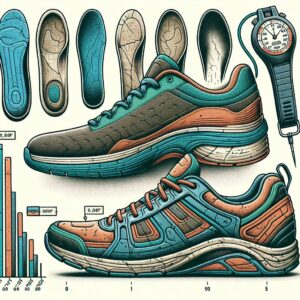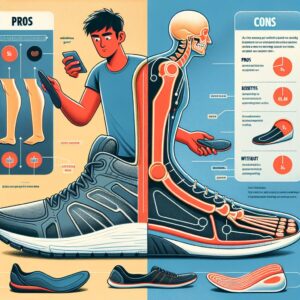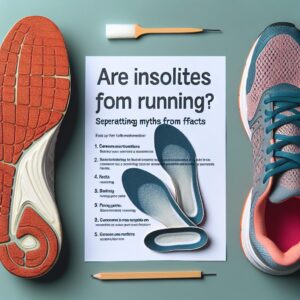-
Table of Contents
- Introduction: The Dilemma of High Heels
- Understanding Heel Grips: What They Are and How They Work
- The Benefits of Using Heel Grips in Your High Heels
- How to Choose the Right Heel Grips for Your High Heels
- A Step-by-Step Guide to Installing Heel Grips
- Real Stories: The Transformative Effect of Heel Grips
- Taking Care of Your Heel Grips: Maintenance Tips
- Conclusion: Elevating Your High Heel Experience
Heel Grips for High Heels: A Foot Health Expert’s Guide to Ultimate Comfort is an informative guide that provides an in-depth understanding of the importance of heel grips for high heels. It is written by a foot health expert who shares his knowledge and expertise on how to achieve ultimate comfort while wearing high heels. The guide covers various aspects such as the role of heel grips in preventing foot problems, different types of heel grips, how to choose the right one, and tips on proper usage. It is an essential read for anyone who frequently wears high heels and seeks to maintain foot health and comfort.
Introduction: The Dilemma of High Heels
High heels, a staple in many women’s wardrobes, are often associated with elegance, sophistication, and power. However, the allure of these stylish shoes is often overshadowed by the discomfort they can cause. The dilemma of high heels is a common one, as many women find themselves torn between the desire to look fashionable and the need for comfort. This is where heel grips for high heels come into play, offering a solution that can help bridge the gap between style and comfort.
Heel grips are small, often adhesive-backed pads that are placed inside the heel area of a shoe. They are designed to provide additional cushioning, prevent slippage, and reduce friction between the shoe and the foot. This can significantly enhance the comfort of wearing high heels, making them more bearable for extended periods.
The effectiveness of heel grips lies in their ability to address some of the most common issues associated with wearing high heels. One such issue is the pressure exerted on the balls of the feet. High heels, particularly those with a height of two inches or more, shift the body’s weight forward, causing the balls of the feet to bear much of the load. This can lead to discomfort and pain, especially after prolonged wear. Heel grips can help alleviate this problem by providing extra cushioning and support, reducing the strain on the balls of the feet.
Another issue that heel grips can help with is slippage. High heels often have a narrow, tapered design that can cause the foot to slide forward, especially when walking. This can lead to blisters, calluses, and other foot problems. Heel grips can prevent this by creating a more secure fit, keeping the foot firmly in place within the shoe.
Friction is another common problem associated with high heels. The constant rubbing of the foot against the shoe can cause blisters and other skin irritations. Heel grips can help reduce this friction, providing a smoother, more comfortable experience.
While heel grips can significantly enhance the comfort of high heels, it’s important to note that they are not a cure-all solution. They can help mitigate some of the discomfort associated with high heels, but they cannot completely eliminate it. High heels, by their very design, put the foot in an unnatural position, which can lead to a variety of foot health issues over time. Therefore, it’s recommended to limit the use of high heels and opt for more foot-friendly footwear whenever possible.
In conclusion, heel grips for high heels can be a valuable tool for those who love the look of high heels but hate the discomfort they can cause. They offer a simple, affordable solution to some of the most common high heel-related issues, making these stylish shoes more bearable for extended wear. However, it’s important to remember that the best way to ensure foot health is to wear comfortable, supportive footwear as much as possible. High heels can be a fun, fashionable choice for special occasions, but they should not be the go-to option for everyday wear.
Understanding Heel Grips: What They Are and How They Work
Heel grips for high heels are an innovative solution designed to provide ultimate comfort and prevent common foot problems associated with wearing high heels. As a foot health expert, I can attest to the numerous benefits of using heel grips, and I am here to guide you through understanding what they are and how they work.
Heel grips are small, often adhesive-backed pads that are placed inside the heel area of a shoe. They are typically made from soft, cushioning materials such as silicone or foam, which provide a comfortable barrier between the shoe and the wearer’s heel. The primary function of heel grips is to prevent the foot from slipping out of the shoe, a common issue experienced by many high heel wearers. This slipping not only causes discomfort but can also lead to blisters, calluses, and other foot problems.
The design of high heels often leaves a gap between the wearer’s heel and the shoe, which is where heel grips come into play. By filling this gap, heel grips ensure a better fit and prevent the foot from sliding, thereby reducing friction and the risk of developing blisters. Moreover, they provide additional cushioning, which can significantly enhance the comfort level, especially when wearing high heels for extended periods.
Heel grips work by adhering to the inside of the shoe, right at the heel area. They are easy to install and can be adjusted to fit any shoe size. Once in place, they create a snug fit for the foot, preventing it from moving around inside the shoe. This secure fit not only enhances comfort but also improves stability and balance, which are often compromised when wearing high heels.
In addition to preventing slippage and providing cushioning, heel grips also help to alleviate pressure on the balls of the feet. When wearing high heels, the body’s weight is shifted forward, placing excessive pressure on the balls of the feet. This can lead to foot pain and conditions such as metatarsalgia. By improving the fit of the shoe, heel grips can help to distribute the body’s weight more evenly across the foot, reducing pressure on the balls of the feet and promoting overall foot health.
While heel grips can significantly improve the comfort and fit of high heels, it’s important to note that they are not a cure-all solution. They should be used in conjunction with other foot health practices, such as wearing properly fitted shoes, taking regular breaks from wearing high heels, and performing foot exercises to strengthen the foot muscles.
In conclusion, heel grips are a practical and effective solution for enhancing the comfort and fit of high heels. They work by filling the gap between the heel and the shoe, preventing slippage, reducing friction, and providing additional cushioning. By doing so, they not only make high heels more comfortable to wear but also promote better foot health. However, they should be used as part of a broader approach to foot health that includes wearing the right shoes and taking care of your feet.
The Benefits of Using Heel Grips in Your High Heels
High heels are a staple in many women’s wardrobes, offering a boost in height and a touch of elegance. However, they can also be a source of discomfort and pain, particularly in the heel area. This is where heel grips come into play. As a foot health expert, I can attest to the numerous benefits of using heel grips in your high heels, which can significantly enhance your comfort and overall foot health.
Heel grips are small, often adhesive-backed pads that are placed inside the heel area of a shoe. They are designed to provide additional cushioning, reduce friction, and prevent the foot from slipping out of the shoe. The benefits of using heel grips in your high heels are manifold, and they can make a significant difference in your comfort and foot health.
One of the primary benefits of heel grips is their ability to reduce friction. High heels often cause the foot to slide forward, creating friction between the foot and the shoe. This friction can lead to blisters, calluses, and other painful foot conditions. Heel grips can help to prevent this by providing a barrier between the foot and the shoe, reducing friction and the associated discomfort.
In addition to reducing friction, heel grips can also provide much-needed cushioning. High heels often lack adequate cushioning, particularly in the heel area. This can lead to heel pain and other foot problems. Heel grips can help to alleviate this by providing additional cushioning in the heel area, reducing pressure on the foot and improving comfort.
Another significant benefit of heel grips is their ability to prevent the foot from slipping out of the shoe. This is a common problem with high heels, particularly those that are slightly too big or have a loose fit. A slipping foot can not only be uncomfortable but can also increase the risk of sprains and other injuries. Heel grips can help to prevent this by providing a better fit and keeping the foot securely in place.
Furthermore, heel grips can also improve balance and stability. High heels can be challenging to walk in, particularly for those who are not used to them. This can lead to instability and an increased risk of falls. Heel grips can help to improve balance and stability by providing additional support and preventing the foot from sliding, making it easier to walk in high heels.
In conclusion, heel grips offer a simple and effective solution to many of the common problems associated with high heels. They can reduce friction, provide additional cushioning, prevent the foot from slipping, and improve balance and stability. So, if you regularly wear high heels and struggle with discomfort or foot pain, consider investing in a pair of heel grips. They could make a significant difference in your comfort and foot health, making your high heels more enjoyable to wear. As a foot health expert, I can confidently say that heel grips are a worthwhile investment for anyone who wears high heels.
How to Choose the Right Heel Grips for Your High Heels

High heels are a staple in many women’s wardrobes, offering a boost in height and a touch of elegance. However, they can also be a source of discomfort and pain, especially when worn for extended periods. One solution to this problem is the use of heel grips, which can significantly enhance the comfort and fit of your high heels. As a foot health expert, I am here to guide you on how to choose the right heel grips for your high heels.
Heel grips are small, often adhesive-backed pads that are placed in the heel area of a shoe to prevent slippage, blisters, and discomfort. They come in a variety of materials, including leather, suede, and silicone. When selecting heel grips, it’s essential to consider the material. Leather and suede grips, for instance, are durable and offer a good level of comfort. However, they may not be as effective in preventing slippage as silicone grips, which have a more substantial grip on the foot.
The thickness of the heel grip is another crucial factor to consider. If your high heels are slightly too big, a thicker heel grip can help fill the extra space and provide a better fit. On the other hand, if your shoes fit well but tend to cause blisters or discomfort, a thinner heel grip may be more suitable. It’s important to remember that while heel grips can improve the fit of your shoes, they cannot make a significantly ill-fitting pair of high heels comfortable.
The shape of the heel grip is also important. Some heel grips are designed to cover the entire heel area, while others only cover a portion. Full-coverage heel grips can provide more comprehensive protection against blisters and discomfort, but they may also make your shoes feel tighter. Partial-coverage heel grips, on the other hand, can offer targeted relief in specific areas without affecting the overall fit of your shoes.
When choosing heel grips, it’s also worth considering the type of adhesive used. Some heel grips have a strong adhesive backing that sticks firmly to the shoe, while others use a gentler adhesive that can be easily removed and repositioned. If you plan to use the heel grips in multiple pairs of shoes, a removable adhesive may be more practical.
Lastly, consider the color of the heel grip. While this may seem like a minor detail, a heel grip that matches the color of your shoes can be less noticeable and more aesthetically pleasing. Most heel grips come in neutral colors like black, brown, and beige, which can blend well with a variety of shoe colors.
In conclusion, choosing the right heel grips for your high heels involves considering several factors, including the material, thickness, shape, adhesive type, and color. By taking these factors into account, you can find heel grips that not only enhance the comfort and fit of your high heels but also help prevent foot health issues like blisters and discomfort. Remember, while high heels can be stylish and elegant, your comfort and foot health should always be a priority.
A Step-by-Step Guide to Installing Heel Grips
Heel grips for high heels are a revolutionary product that has been designed to provide ultimate comfort to those who love to wear high heels. These small, yet highly effective, accessories can significantly reduce the discomfort and pain often associated with wearing high heels for extended periods. As a foot health expert, I can attest to the benefits of heel grips and would like to provide a step-by-step guide to installing them correctly for maximum comfort and effectiveness.
The first step in installing heel grips is to ensure that your high heels are clean and dry. This is crucial as any dirt or moisture can interfere with the adhesive on the heel grips, reducing their effectiveness. You can clean your high heels using a damp cloth and then allow them to dry completely before proceeding to the next step.
Once your high heels are clean and dry, you can proceed to the next step, which involves positioning the heel grips. It is important to note that heel grips should be placed at the back of the shoe, where your heel would normally rest. To ensure correct positioning, you can put on your high heels and mark the area where your heel rests. This will give you a clear indication of where to place the heel grips.
After marking the correct position, you can now proceed to peel off the adhesive backing from the heel grips. Be careful not to touch the adhesive side as this can reduce its stickiness. Once the adhesive backing is off, you can now place the heel grip in the marked position. Press it firmly against the shoe to ensure that it sticks properly. Repeat the process with the other shoe.
Once the heel grips are in place, it is advisable to let them sit for a few minutes before wearing the shoes. This allows the adhesive to bond properly with the shoe material, ensuring that the heel grips stay in place even when you are walking or dancing.
After the adhesive has had time to bond, you can now put on your high heels. You should immediately notice a difference in comfort. The heel grips should provide a cushioning effect, reducing the pressure on your heels. They should also prevent your feet from slipping out of the shoes, a common problem when wearing high heels.
In conclusion, heel grips for high heels are a simple yet effective solution for the discomfort associated with wearing high heels. By following the above step-by-step guide, you can easily install heel grips in your high heels and enjoy a more comfortable and pain-free experience. However, it is important to remember that while heel grips can provide temporary relief, they are not a cure for chronic foot pain or other serious foot health issues. If you experience persistent pain or discomfort when wearing high heels, it is advisable to consult a foot health expert for a comprehensive evaluation and treatment.
Real Stories: The Transformative Effect of Heel Grips
High heels are a staple in many women’s wardrobes, offering a boost in height and a touch of elegance. However, the discomfort and potential foot health issues associated with prolonged wear of high heels are well-documented. This is where heel grips come into play. As a foot health expert, I have seen firsthand the transformative effect of heel grips on my clients’ comfort and overall foot health.
Heel grips are small, often adhesive-backed pads that are placed inside the heel area of a shoe. They serve a dual purpose: to prevent the foot from slipping out of the shoe and to provide additional cushioning. This seemingly simple accessory can make a world of difference in the comfort and wearability of high heels.
One of my clients, a professional dancer, was on the verge of giving up her passion due to the excruciating pain she experienced from wearing high heels during performances. Despite trying various shoe styles and sizes, the pain persisted. It was only when she started using heel grips that she noticed a significant improvement. The heel grips provided the much-needed cushioning and stability, reducing the pressure on her feet and allowing her to dance without discomfort.
Another client, a corporate executive who often wore high heels to work, complained of blisters and calluses caused by her feet sliding in her shoes. The introduction of heel grips into her footwear routine not only prevented her feet from sliding but also reduced the friction between her feet and shoes, thereby preventing the formation of blisters and calluses.
Heel grips are not just for those who wear high heels regularly. They can also be beneficial for those who wear heels occasionally, such as for special events. One of my clients, who rarely wore heels, found them particularly uncomfortable and difficult to walk in. However, she had an upcoming event that required her to wear heels. After using heel grips, she reported that her heels felt more secure and comfortable, and she was able to enjoy the event without worrying about foot pain or slipping out of her shoes.
While heel grips can significantly improve the comfort of wearing high heels, it’s important to remember that they are not a cure-all solution. Prolonged wear of high heels can still lead to foot health issues such as bunions, hammertoes, and nerve damage. Therefore, it’s crucial to wear high heels in moderation and to give your feet a break by alternating with comfortable, supportive footwear.
In conclusion, heel grips can be a game-changer for those who wear high heels, whether regularly or occasionally. They can provide additional cushioning, prevent the foot from sliding, and reduce the risk of blisters and calluses. However, they should be used as part of a broader approach to foot health that includes wearing high heels in moderation and alternating with other types of footwear. As a foot health expert, I highly recommend giving heel grips a try if you’re struggling with discomfort when wearing high heels. You might be surprised at the difference they can make.
Taking Care of Your Heel Grips: Maintenance Tips
Heel grips for high heels are a godsend for many women who love to strut in their stilettos but dread the discomfort that often accompanies wearing high heels for extended periods. As a foot health expert, I can attest to the fact that these small, often overlooked accessories can make a world of difference in terms of comfort and foot health. However, to ensure that your heel grips continue to provide the ultimate comfort, it is essential to take proper care of them. Here are some maintenance tips that can help prolong the life of your heel grips and keep your feet happy.
Firstly, it is crucial to clean your heel grips regularly. This is because sweat, dirt, and bacteria can accumulate on the surface of the grips over time, which can not only lead to unpleasant odors but also increase the risk of foot infections. To clean your heel grips, simply remove them from your shoes and wash them gently with warm water and mild soap. Avoid using harsh detergents or scrubbing too hard as this can damage the material of the grips. After washing, pat them dry with a clean towel and let them air dry completely before reinserting them into your shoes.
Secondly, it is advisable to rotate your heel grips between different pairs of shoes. This allows the grips to regain their shape and elasticity, thereby ensuring that they continue to provide optimal support and cushioning for your heels. If you wear the same pair of heel grips in the same shoes every day, the constant pressure and friction can cause the grips to wear out faster. Therefore, having multiple pairs of heel grips and rotating them can help extend their lifespan.
Thirdly, inspect your heel grips regularly for signs of wear and tear. Over time, the material of the grips can become thin and lose its cushioning properties, which can reduce their effectiveness in providing comfort and preventing blisters. If you notice that your heel grips are starting to wear out, it is best to replace them as soon as possible to avoid discomfort or potential foot problems.
Lastly, store your heel grips properly when they are not in use. Keep them in a cool, dry place away from direct sunlight, as heat and humidity can degrade the material of the grips. Also, avoid folding or crumpling the grips as this can cause them to lose their shape and effectiveness.
In conclusion, taking proper care of your heel grips can significantly enhance their durability and effectiveness in providing comfort when wearing high heels. Regular cleaning, rotation between shoes, timely replacement, and proper storage are all essential maintenance practices that can help ensure your heel grips continue to serve you well. Remember, your feet carry you through life, so it’s only fair that you take good care of them. And with well-maintained heel grips, you can enjoy the elegance of high heels without compromising on comfort or foot health.
Common Questions Answered about Heel Grips for High Heels
Heel grips for high heels are a popular solution for women who experience discomfort or instability when wearing high-heeled shoes. These small, often adhesive-backed pads are designed to fit snugly inside the heel of a shoe, providing additional support and preventing the foot from slipping out. Despite their popularity, many women have questions about the use and effectiveness of heel grips. This article aims to answer some of the most common queries, providing a foot health expert’s guide to ultimate comfort.
One of the most frequently asked questions is whether heel grips can actually make high heels more comfortable. The answer is a resounding yes. Heel grips are designed to provide additional cushioning in the heel area, reducing the pressure and friction that can cause discomfort and blisters. They also help to improve the fit of the shoe, preventing the foot from sliding forward and reducing the strain on the toes and the ball of the foot.
Another common question is whether heel grips can prevent the foot from slipping out of high heels. Again, the answer is yes. Heel grips are designed to provide a more secure fit, helping to keep the foot firmly in place. This can be particularly beneficial for women who have narrow heels or who find that their feet tend to slip out of their shoes, especially when they are new or when the wearer is walking on slippery surfaces.
Many women also wonder if heel grips can be used with all types of high heels. The good news is that heel grips are versatile and can be used with most types of high-heeled shoes, including stilettos, pumps, and wedges. However, it’s important to note that the effectiveness of heel grips can vary depending on the design of the shoe and the individual’s foot shape and size.
A question that often arises is whether heel grips can cause damage to the shoes. The answer to this is generally no. Most heel grips are made from soft, flexible materials that are unlikely to cause damage. However, it’s always a good idea to test the adhesive on a small, inconspicuous area of the shoe first.
Finally, many women are curious about how to choose the right heel grips for their needs. When selecting heel grips, it’s important to consider the size and shape of the shoe, as well as the wearer’s foot. The grips should fit snugly inside the heel of the shoe without causing discomfort or altering the fit of the shoe. It’s also worth considering the material of the grip. Some are made from soft foam or gel, which can provide additional cushioning, while others are made from leather or suede, which can offer a more secure grip.
In conclusion, heel grips can be an effective solution for women who experience discomfort or instability when wearing high heels. They can provide additional support and cushioning, improve the fit of the shoe, and prevent the foot from slipping out. However, as with any foot care product, it’s important to choose the right heel grips for your needs and to use them correctly to ensure the best results.
Conclusion: Elevating Your High Heel Experience
In conclusion, the use of heel grips for high heels can significantly elevate your high heel experience, providing a level of comfort that is often elusive when wearing these stylish yet notoriously uncomfortable shoes. As a foot health expert, I can attest to the numerous benefits that heel grips offer, particularly in terms of enhancing comfort and promoting foot health.
Firstly, heel grips are instrumental in preventing the common problem of heel slippage. This issue often arises when wearing high heels, leading to discomfort and instability. By providing a secure fit, heel grips can effectively eliminate this problem, allowing you to walk with confidence and ease. This not only enhances your comfort but also reduces the risk of accidents and injuries that can result from slipping out of your heels.
Moreover, heel grips can significantly alleviate the pressure and strain that high heels typically place on your feet. High heels, particularly those with a height of more than two inches, can cause an unnatural distribution of weight on your feet, leading to discomfort and potential foot problems. Heel grips can help to redistribute this weight more evenly across your feet, thereby reducing pressure and strain. This can go a long way in preventing foot conditions such as bunions, corns, and calluses, which are often associated with prolonged high heel use.
In addition to these benefits, heel grips can also provide much-needed cushioning for your feet. High heels, especially those with thin soles, offer little to no cushioning, which can result in foot pain and discomfort. Heel grips, on the other hand, are typically made of soft, cushioning materials that can provide a layer of comfort for your feet. This can make a significant difference in your high heel experience, allowing you to wear your favorite pair of heels for longer periods without discomfort.
Furthermore, heel grips can also help to improve the fit of your high heels. If your heels are slightly too big, heel grips can fill in the extra space, providing a better fit. This can not only enhance your comfort but also improve the overall look and feel of your heels.
Lastly, it’s worth noting that heel grips are easy to use and can be conveniently inserted and removed from your heels. This means that you can use them as needed, depending on the specific pair of heels you’re wearing and the amount of time you plan to spend in them.
In conclusion, heel grips for high heels can significantly enhance your high heel experience, providing a level of comfort and stability that is often lacking when wearing these shoes. By preventing heel slippage, alleviating pressure and strain, providing cushioning, and improving fit, heel grips can help to promote foot health and prevent foot problems associated with high heel use. As a foot health expert, I highly recommend the use of heel grips for anyone who wears high heels regularly. They are a simple, affordable, and effective solution to the common problems associated with high heel use, and can truly elevate your high heel experience to a whole new level of comfort.Heel grips for high heels are essential tools for enhancing comfort and promoting foot health. They prevent blisters, reduce slippage and improve shoe fit, making high heels more comfortable to wear. Therefore, they are highly recommended for individuals who frequently wear high heels.







